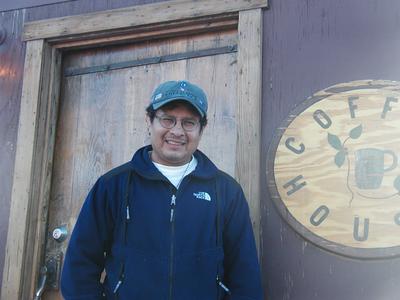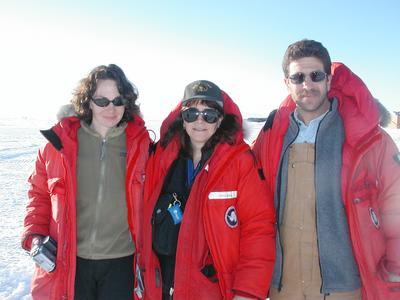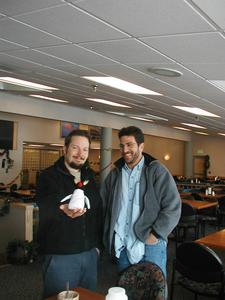
|
|
20 December, 2001

I saw Chico Perales at the Coffee House when I stopped by to say goodbye to some friends. It is very easy to loose track of time in Antarctica as one day runs into the next. It is light 24 hours a day during the austral summer, so it comes as no surprise to see people out walking around McMurdo past the midnight hour. Despite the early morning hour, the temperature was unbelievably warm for this time of year. It was a light jacket and baseball cap type of day. After many flight cancellations, today looks promising for my departure home. My flight was first scheduled for 1 a.m. on December 13th. For days, I have been scheduled to be on the first flight off the Pegasus runway. (The Pegasus Runway, which is on a glacier on the Ross Ice Shelf, had to be "dug out" and compacted after the blizzard). Since this would be my last opportunity, I wanted to walk down to the Discovery Hut at the end of the Hut Point Peninsula. Chico, who has come nine times to Antarctica, gave me an informative tour as we walked near the ice pier enroute to the Hut. Chico's perspective of Antarctica comes out in his "Spanish Word for the Day" e-mails, as well as in his penguin comic strip in the weekly newspaper, The Antarctic Sun . Chico is from El Paso, Texas, but he has traveled extensively around the United States working in heavy construction. He has been involved with building nuclear plants and paper mills. He is a "jack-of-all trades" working as a welder, iron and sheet metal worker, foreman, and doing whatever needs to be done. He said he rebuilds things that don't work by brainstorming to get new ideas. Chico has a wealth of knowledge , so the walk became a history lesson. It was a wonderful way to begin my last day in Antarctica.

The historic Discovery hut, within an easy walking distance from the McMurdo Research Station on Ross Island, is situated at the end of a promontory known as Hut Point (77degrees 51' S latitude, 166 degrees 38 ' E longitude). The building was erected during Robert Falcon Scott's Discovery expedition, but was also used by subsequent expedition parties, including Ernest Shackleton's. Some expeditions used it primarily for drying tents or making repairs, while some expeditions used the building for accommodations and shelter from the extreme cold weather. To learn more about this building and other historic sites near this region, I found David Harrowfield's Icy Heritage, Historic Sites of the Ross Sea Region to be quite informative. The descriptions and photos give a greater understanding of this region and the hardships endured by these early explorers during what is known as the "heroic era" of exploration in Antarctica.

The cross in memory of G.T. Vince is located near Discovery hut on the cliff overlooking the sea. On March 11, 1902, Vince drowned tragically as his fur boots lost traction on the ice during a blizzard near Castle Rock. As he tried to make his way back to Discovery (his ship), he slipped off an ice cliff into the sea. Vince was the first person to die in McMurdo Sound, and the cross is a reminder of the vulnerability and hardships faced by the early Antarctic explorers. It is also a reminder that safety and precautions are still a concern for those working in Antarctica today. Despite the advanced technology, equipment, gear, and shelter, Antarctica is very much in control. The weather conditions may change within seconds, so hand-held radios and survival gear are imperative for venturing outdoors in Antarctica. Communication checks are required when leaving McMurdo Station for even a brief field trip. While in our field camp at Explorers Cove, a "com" check was made to McMurdo Operations at the same time each morning. A hand-held radio was always carried to the dive hut or to dive holes on the sea ice. Constant contact and adhering to "strict scheduled" times for departure or returns to the field camp were essential in maintaining safety in such an unpredictable environment. Antarctica is still today a great white unknown. It is a land of constant surprises, and one that humbles, frustrates, yet exhilarates…as it leaves one feeling so fortunate to experience one of the last great "wilderness frontiers".

Chico Perales looking out over the sea ice near the cross at the end of the Hut Point Peninsula.

I met Randy Landsberg (Director of Education and Outreach for CARA) and Vivian Trakinski (with the American Museum of Natural History) in McMurdo upon their return from the South Pole. We first met at the "bag drag" on December 12th, when we checked our luggage for our flight to Christchurch, New Zealand. Since we were scheduled to leave on the same flight, we had several occasions to talk as we checked the flight board, which became a "daily ritual" for flight cancellations. (Photos of the blizzard: See December 15th journal entry). Today is December 20th, and we think this flight may actually depart as scheduled. It was a pleasure to meet this group and learn more about their project. I was already aware of CARA (Center for Astrophysical Research in Antarctica) before I came to Antarctica. In 1997, Randy and Janice VanCleave (a well-known author of science books and projects), spent two weeks at the South Pole for a "South Pole Adventure" to perform experiments and answer questions from students. The CARA website has wonderful information on science research, experiments, activities, and life in Antarctica. (http://astro.uchicago.edu/cara)

Jason Leichuk,( the cinematographer/ cameraman) and Randy Landsberg are here with Vivian Trakinski to put together a museum exhibit about DASI (Degree Angular Scale Inferometer) , which is housed in the Dark Sector at the Amundsen-Scott South Pole Station. The DASI is a computer-operated "cosmic microwave detector telescope", which has a total weight of 35,000 pounds. The DASI is designed to collect highly sensitive and detailed images, which according to Randy, looks at light from the early universe. To find out more information, check out the CARA website's "Randy and Friends Travel to the South Pole", as well as additional information about the project. The South Pole's Dark Sector has the unique characteristics, which make the CARA project possible. The South Pole has long, cold winters, access to long periods of darkness to study the expansive sky, and stable, dry conditions. The Dark Sector is a place free of light pollution (no artificial lights from nearby cities or buildings), as well as minimal electro-magnetic radiation interference.
Contact the TEA in the field at
.
If you cannot connect through your browser, copy the
TEA's e-mail address in the "To:" line of
your favorite e-mail package.
|
